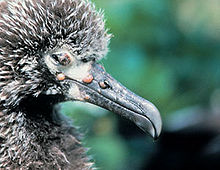Avipoxvirus: Difference between revisions
m Bot: fixing title linked in text |
Jboltonnal (talk | contribs) |
||
| Line 38: | Line 38: | ||
* [http://www.expasy.org/viralzone/all_by_species/151.html '''Viralzone''': Avipoxvirus] |
* [http://www.expasy.org/viralzone/all_by_species/151.html '''Viralzone''': Avipoxvirus] |
||
* [http://www.viprbrc.org/brc/home.do?decorator=pox Virus Pathogen Database and Analysis Resource (ViPR): Poxviridae] |
* [http://www.viprbrc.org/brc/home.do?decorator=pox Virus Pathogen Database and Analysis Resource (ViPR): Poxviridae] |
||
* [http://www.invasivespeciesinfo.gov/microbes/fowlpox.shtml Species Profile- Fowlpox (''Avipoxvirus'')], National Invasive Species Information Center, [[United States National Agricultural Library]]. Lists general information and resources for Fowlpox. |
|||
[[Category:Poxviruses|*]] |
[[Category:Poxviruses|*]] |
||
Revision as of 19:05, 16 February 2011
| Avipoxvirus | |
|---|---|
| Virus classification | |
| Group: | Group I (dsDNA)
|
| Order: | Unassigned
|
| Family: | |
| Subfamily: | |
| Genus: | Avipoxvirus
|
| Type species | |
| Fowlpox virus | |
| Species | |
|
Canarypox virus | |

Avipoxvirus is a member of the Poxviridae family. The Poxviridae family is the family of viruses which cause the victim organism to have poxes as a symptom. This pox virus is one that affects birds only. Poxviruses have generally large genomes, and other such examples include smallpox and monkeypox. Although it is comparably slow-spreading, Avipoxvirus is known to cause symptoms like pustules full of pus lining the skin and diphtheria-like symptoms. These diphtheria-like symptoms might include dipitheric necrotic membranes lining the mouth and the upper respiratory tract. This disease can be transmitted to humans by unusually close contact with birds that are infected or the consuming of liquids or solids that have been in extremely close contact with an infected bird. Not unlike other avian viruses, it can be transmitted through vectors mechanically such as through mosquitoes.[1]
Avipoxvirus is a virus that is brick shaped and is usually 200 nanometers in diameter. This is much larger than normal viruses which are around 60 nanometers in diameter. This virus can only be contracted through vectors and consumption of infected items, but they can be filtered by a special water filter. This filter is called a Large Volume Water Sampler (LVWS).
Unlike other viruses, avipoxvirus can withstand extreme dryness. With this advantage, it can spread on dust particles. This is because it has adapted to living in the dry mucous membranes of an infected host's upper respiratory tract.
As this virus is a poxvirus, it has a high mortality rate in birds, like it does in humans. The effects of this virus might increase the difficulty of breathing, eating, and drinking significantly. Exterior lesions are restricted to the non-feathered parts of the body, usually the face and legs and are characterized by proliferative and necrotizing dermatitis.[2] Another feature of this bird pox that has been observed is the presence of blood sacs or blisters filled with bloody fluid that will collapse when pierced with a needled and allowed to drain.[3] This virus has the highest mortality rate in upland gamebirds such as songbirds, marine birds such as seagulls, parrots, and some raptors such as the peregrine falcon. If the victim of the virus survives long enough to breed, then the offspring will become mentally retarded[citation needed].
Other names for this peculiar virus might include avian pox, fowlpox, canarypox, juncopox, mynahpox, and many other names that correspond with its peculiar characteristics.
References
- ^ "Fowlpox in Chickens and Turkeys". The Merck Veterinary Manual. 2006. Retrieved 2007-06-21.
- ^ DISEASES OF WILDLIFE: AFIP REVIEW OF GROSS MORBID ANATOMY OF ANIMALS by John R. Fischer Published by C.L. DAVIS, DVM FOUNDATION MARCH 22, 1999. Accessed Jul 10 2007
- ^ ABNORMALITIES IN BIRDS WITH FOUR ILLUSTRATIONS By HAROLD MICHENER and JOSEPHINE R. MICHENER Division of Zoology, University of California, Davis, California, January 23, 1936. Accessed July 10, 2007
External links
- Viralzone: Avipoxvirus
- Virus Pathogen Database and Analysis Resource (ViPR): Poxviridae
- Species Profile- Fowlpox (Avipoxvirus), National Invasive Species Information Center, United States National Agricultural Library. Lists general information and resources for Fowlpox.
